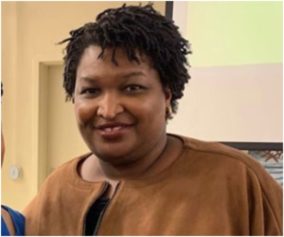
(William Lovelace/Stringer/Hulton Archive/Getty Images/Wikimedia Commons)
“I was especially concerned to try to convey its long continuous movement, flowing like a river, sometimes powerful, tumultuous, and roiling with life; at other times meandering and turgid, covered with ice and snow of seemingly endless winters, all too often streaked and running with blood.” — Vincent Harding, There Is a River: The Black Struggle for Freedom in America, 1981
For better or worse, modern Black struggle in America has commonly been condensed to a pivotal two-decade period in the middle of the 20th century where two constructs of change dominated the national narrative — civil rights and Black power. On one hand, the disruptive years between the mid-1950s and mid-1970s cannot be understated in terms of their significance, accomplishments and their legacy, one still impacting our American experience today. On the other, given America’s penchant for historical cover stories, this important era has often been reduced to its perceived schisms and notable events while simultaneously minimizing the important developments that both preceded and enabled it.
The conventional approach tells a story of two mostly separate movements — a decade-long struggle for civil rights based in nonviolent resistance and a movement for empowerment anchored in Black nationalism and self-defense. The former is prefaced by the Brown v. Board of Education decision of May 1954 and the brutal murder of 14-year-old Emmett Till in August 1955, then launched in December 1955 by Rosa Parks’ refusal to give up her seat on an Alabama bus before ending with the 1968 murder of Martin Luther King, Jr. The latter found its prologue in the separatist agenda of the Nation of Islam and Malcolm X, was galvanized by the Watts uprising of 1965 and Stokely Carmichael’s ideological projections of “Black Power” in 1966, and then advanced by the Black Panther Party for Self Defense until its state-orchestrated demise by the mid-70s. The two movements, the story goes, were unique and loosely related phenomena best exemplified by such polarized ideological constructs as “nonviolence vs. violence,” “civil rights vs. Black power” and “integration vs. nationalism.”
Some believe such generalized historical accounts miss the mark.
“I would see them as complementary more so than anything else,” says Gerald Horne, the John J. and Rebecca Moores Chair of History and African American Studies at the University of Houston. The prolific historian is author of over 30 books, including the upcoming “Facing the Rising Sun: African Americans, Japan and the Rise of Afro-Asian Solidarity.” While noting the limited analytical value of such a conventional two-tiered construct, Horne says, “I think they both played a role” and both had “their assets and their liabilities.”
“They are interrelated struggles and the one grows out of the other,” says Paul Coates, owner of Black Classic Press, one of the oldest Black-owned publishing institutions in the country. The former Black Panther leader notes how the civil rights movement recedes in the late ’60s as “what we look at as the Black Power movement really comes in to fore” with the “more confrontational extension of demands” for Black liberation and human rights. Coates clarifies “they are connected and part of the same struggle.”
Given the common lack of nuance in the stories America tells itself about itself — and a common lack of historical knowledge amongst its citizens — Horne feels simplified historical accounts can often fog a broader, more valuable lens. “Another way of looking at the retreat of U.S. apartheid, which is really what we are talking about, would lengthen that time period to talk about the arrival of the first Africans in North America hundreds of years ago and say that the struggle is continuing,” he said. A more focused version, he says, would consider the Scottsboro case in the 1930s “when there was an international movement against U.S. apartheid, which led to significant advances” and an ensuing retreat by the American ruling class “away from the more egregious aspects of apartheid.” This retreat, continues Horne, eventually manifested “with the Brown v. Board of Education case” in 1954, which then “helped to inaugurate a series of changes” that brought about the dismantling of Jim Crow.
Accordingly, none of this occurred in a vacuum. The first half of the 20th century saw significant movement and mass mobilizations on a number of overlapping fronts, including civil rights, nationalism and labor. The National Association for the Advancement of Colored People (NAACP), founded in 1909, organized around anti-lynching, legal and voting advocacy and, by 1919, had grown its membership to 90,000. Such growth, while admirable, paled in comparison to the massive membership and nationalistic influence of Marcus Garvey’s Universal Negro Improvement Association (UNIA) — commonly regarded as the largest mass movement in Black history — which, by 1922, had two million American members and, by 1926, over six million worldwide. Influenced by the 19th-century cultural nationalism of Martin Delany and Henry McNeal Turner, the economic nationalism of Booker T. Washington, the militant socialism of Hubert Harrison and an active Pan-Africanism, Garvey connected the struggle of Black people in America with those across the globe through media, industry and a common critique of white supremacy and imperialism. After its heyday, the UNIA’s 700 branches in 38 states would feed the ranks of the labor movement as well as such groups as Father Divine’s Universal Peace Mission Movement, the Moorish Science Temple of America and the Nation of Islam.
Along with Garvey’s globalism, African-Americans in the labor movement also employed an internationally based critique of the plight of Black folks at home. Such critiques were heavily based in socialism given its ideological emphasis upon worldwide equity, the dehumanizing excesses of American capitalism and the impact of key international conflicts including World War I and the Bolshevik revolution. Black labor leaders like A. Philip Randolph and William Patterson advanced the related causes of economic and racial equity while criticizing American claims of democratic “exceptionalism” given the lynching and inequitable treatment of its darker citizens. Randolph commenced the March on Washington Movement in 1940 — over two decades before he’d organize the pivotal 1963 march highlighted by King — to protest segregation and the hypocrisy of “defending democracy” from Hitler when African-Americans were shackled by Jim Crow at home. A week before the scheduled march date of July 1, 1941, with over 100,000 people planning to converge on the capitol, President Franklin D. Roosevelt issued Executive Order 8802 establishing the first Fair Employment Practices Committee in exchange for Randolph’s cancellation of the event. And in 1951, Patterson, along with Paul Robeson, Mary Church Terrell and other prominent African-Americans, petitioned the United Nations to charge the United States government with genocide, presenting hundreds of documented cases of murder, firebombing and torture of its Black citizens.
Taking this larger historical approach, one reminiscent of historian Vincent Harding’s river metaphor — the civil rights and Black power constructs become less distinct and more fluid and intertwined as tributaries of the same long struggle for Black liberation in America. Indeed, it is a struggle waged upon the high seas of the Middle Passage as Africans shackled together in hellish conditions resisted by attempting to overcome their captors or by throwing themselves into the shark-infested waters of the Atlantic. It is a struggle waged by enslaved Africans of varied tongues on plantations who communicated by song and drum to escape their savage white captors, or die trying. It is a struggle embodied by the plotted rebellion of Gabriel Prosser; the defiant appeal of David Walker; the successful rebellion of John Horse and the Black Seminoles; the biblical bloodshed of Nat Turner; the societal critique of Sojourner Truth; the daring rescue missions of Harriet Tubman; the pioneering Black nationalism of Martin Delany; the bold legal challenge of Dred Scott; the anti-lynching crusade of Ida B. Wells; the proud Pan-Africanism of Marcus Garvey; the fearless organizing of Rosa Parks on behalf of Black domestics against their white rapists long before her orchestrated act of defiance on an Alabama bus; the courtroom posture of Emmett Till’s uncle, Mose Wright; the tireless organizing of Bob Moses and Diane Nash; the self-determination of the Nation of Islam; the unyielding Blackness of Malcolm X; the armed protection of the Deacons for Defense and Justice; the brash dissent of Muhammad Ali; the unabashed militancy of Robert Williams; the fiery frustration of the long, hot summer; the since-sanitized radicalism of Martin Luther King; the outspokenness of Fred Hampton; the revolutionary commitment of George and Jonathan Jackson; the unbreakable spirit of Geronimo Ji Jaga Pratt; the unshakable intellectual prowess of Angela Davis; and the indelible legacy of the Black Panther Party for Self-Defense.
And, for some, the river still flows.
“I hold that many of the people from the Black power movement actually moved on to doing the work of Black empowerment,” says Coates, noting it became less about “facing white people down with guns, and more about the building of institutions.” He cites the proliferation of independent Black schools and other institutions during and in the aftermath of the movement, a significant number which remain to this day. Not only that, says Coates, “I don’t think a lot of people look at how the Black Power movement was a movement of consciousness. That consciousness is embodied in a whole generation of people, and those people are now in institutional positions, people we meet and greet every day.
“When you talk about Black Lives Matter, that movement arose out of a consciousness that was already there,” continues Coates. The actions of quarterback Colin Kaepernick and “the fact he wears visible signs that connect him to something in the past says he is connected to a consciousness” which is “an ongoing consciousness.”
These folks, Coates adds, are “definitely within the center stream of a consciousness that comes out of the Black Power movement and still exists strongly today.”


